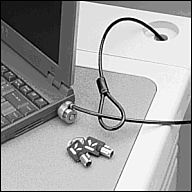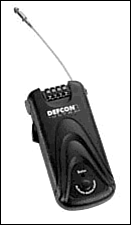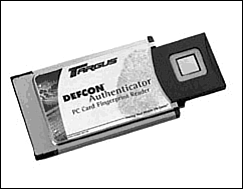Security Devices
| Because it is so easy for laptops to be stolen, manufacturers have developed a number of security options for these devices. These range from simple cable systems that lock down notebooks to sophisticated software that will alert you to the notebook's location in the event that it is stolen. Note that two elements of a notebook must be guarded : its hardware and its data. Theft DeterrentsThe most common and most affordable security devices for notebooks are those designed to prevent or deter theft. Although these devices diminish the convenience of notebooks, a minor inconvenience is much preferable to the serious problem of a stolen notebook. Cable LocksAll notebooks have at least one security socket called a Kensington lock slot . The name derives from the fact that this slot was originally designed to be used with a cable lock developed by Kensington, a large vendor of computer accessories. The Kensington lock slot looks like a small keyhole and is often labeled with a small icon (see Figure 14.14). Each lock has a small tongue that can be inserted into this slot. When the internal T-shaped spindle of the tongue is rotated , the tongue firmly attaches to the slot. The only way to remove the lock without damaging the laptop is to use the correct key or combination. The locks are securely attached to cables of various sizes and thicknesses (see Figure 14.15). Although Kensington originally developed this type of cable lock, similar locks are available from other vendors . Figure 14.14. The Kensington Lock icon is used to identify security slots on notebooks. Figure 14.15. The Kensington Slim MicroSaver Security Cable is one of the most popular cable locks for notebooks. Some notebook designers have placed the Kensington lock slot in ingenious places. For example, if the slot is placed near the PC Card slots, the lock prevents theft not only of the notebook but also of the PC Cards. Similarly, some notebook manufacturers place the lock slot near the hard drive cover. Lock PlatesAlthough cable locks can provide a reasonable amount of security, a good quality pair of metal shears or simple bolt cutters can cut many of them. For better security, many companies use lock plates that securely bolt a notebook to a tabletop surface. These plates are made of steel and are about the size of a laptop. The plates have several small holes enabling users to secure them to a table surface with screws . Brackets can attach to the top of the plate to lock down a laptop, usually by its side panels. These brackets can only be removed with the correct key. A few notebooks have optional docking stations that are sturdy enough to serve as lock plates. Although docking stations are usually constructed of plastic rather than steel, they can provide enhanced connectivity along with security. Although a lock plate provides excellent theft deterrence, it completely immobilizes a notebook and requires extensive modifications to a table surface. Motion DetectorsTargus, a large vendor of laptop accessories, sells a line of theft-deterrent devices that rely on motion detection (see Figure 14.16). These devices securely attach to a notebook via the Kensington lock slot. When the user activates the motion detector, the device may be triggered if the notebook is moved slightly. Once the motion detector is triggered, the user has a short time to enter a deactivation code before a loud alarm goes off. Figure 14.16. The Targus DEFCON 1 Ultra Notebook Security Alarm combines a cable lock with a motion detector. Motion detectors are small and fairly inexpensive. Their best application is in situations where users have to leave their equipment temporarily but cannot secure it sufficiently with cable locks. Laptop Recovery SystemsSome new car purchasers equip their automobiles with a radio-equipped antitheft device. If the car is ever stolen, police cars equipped with special radio equipment can zero in on the exact location of the car. A similar technique is available for notebook users. It is based on a special type of software program that can be installed on the notebook's hard drive. According to the companies that sell the software, the thief cannot erase the program, even if the hard drive is reformatted. When the thief uses the notebook, the software asks for a password. If the password is not given, and the notebook is subsequently connected to the Internet, it will send a message to a central Web site, stating that the notebook has been stolen. By analyzing the trail that the messages from the notebook have taken, these companies say they can pinpoint the geographic position of the stolen notebook and notify police. The two most respected examples of these tracking programs are ComputracePlus (www.computrace.com) and zTrace (www.ztrace.com). User Authentication DevicesAlthough the loss of a notebook with all its data is a catastrophe, the loss of this same data to a business competitor is immeasurably worse . Fortunately, several notebook accessories are designed to ensure you are the only person who can access the data on your notebook. SmartCard KeysMost user-authentication techniques depend on passwords. But because passwords are cumbersome to use and can sometimes be obtained by guesswork and eavesdropping, many security experts prefer a hardware-based authentication technique. The oldest of these methods involves using a SmartCard, a credit card “like device with an embedded memory chip. These cards are similar to the cards that were once popular in Europe for use with payphones. The easiest way to equip a laptop with a SmartCard technology is to insert a PC Card “based SmartCard reader. When loaded with corresponding security software, the laptop will be usable only when the PC Card SmartCard reader and the correct SmartCard are inserted. In an effort to secure its massive fleet of notebook computers, the U.S. Air Force is purchasing thousands of CardMan PC Card SmartCard readers from a company called Omnikey. By using this system, service members will be able to verify their identification and use the technology for secure access to computer systems and to digitally encrypt and sign email. USB KeysThe use of a SmartCard key requires laptops to be equipped with a SmartCard reader, which ties up a modular device bay or a PC Card slot and entails additional expense. For that reason, security companies now offer a USB key, which can be inserted into the USB slots that are now standard equipment on all notebooks as well as desktops. The USB keys offer an advantage in that they protrude from the notebook and have a key-chain hoop, making it less likely that a user will accidentally leave the key attached to the laptop, as frequently happens with SmartCards. Fingerprint SensorsHardware-based keys such as SmartCards and USB keys have the disadvantage that they can be stolen. For that reason, they are often backed up with password protection, which makes their use less convenient . The best security key is one that is almost impossible to steal and something that the users always carry with them. Many companies bet that this ideal security key is right at our fingertips. Fingerprint sensors have been refined to the point that they are very accurate. These sensors are available for notebooks as a small device that attaches to a USB port or a PC Card with a fingerprint reader that pops out of the side of the notebook. Fingerprint readers have the enviable advantage of being both very convenient and highly secure. A few notebook manufacturers have offered notebooks with fingerprint readers as integral devices located just below the keyboard. Perhaps the most popular fingerprint reader is the Targus DEFCON Authenticator (see Figure 14.17). This is a PC Card that has a pop-out fingerprint reader. When you need to verify your identity, you can pop out the postage stamp “size reader. At all other times, it can be safely stored inside your laptop. Figure 14.17. The Targus DEFCON Authenticator is a PC Card that has a pop-out fingerprint reader. |
EAN: 2147483647
Pages: 182



